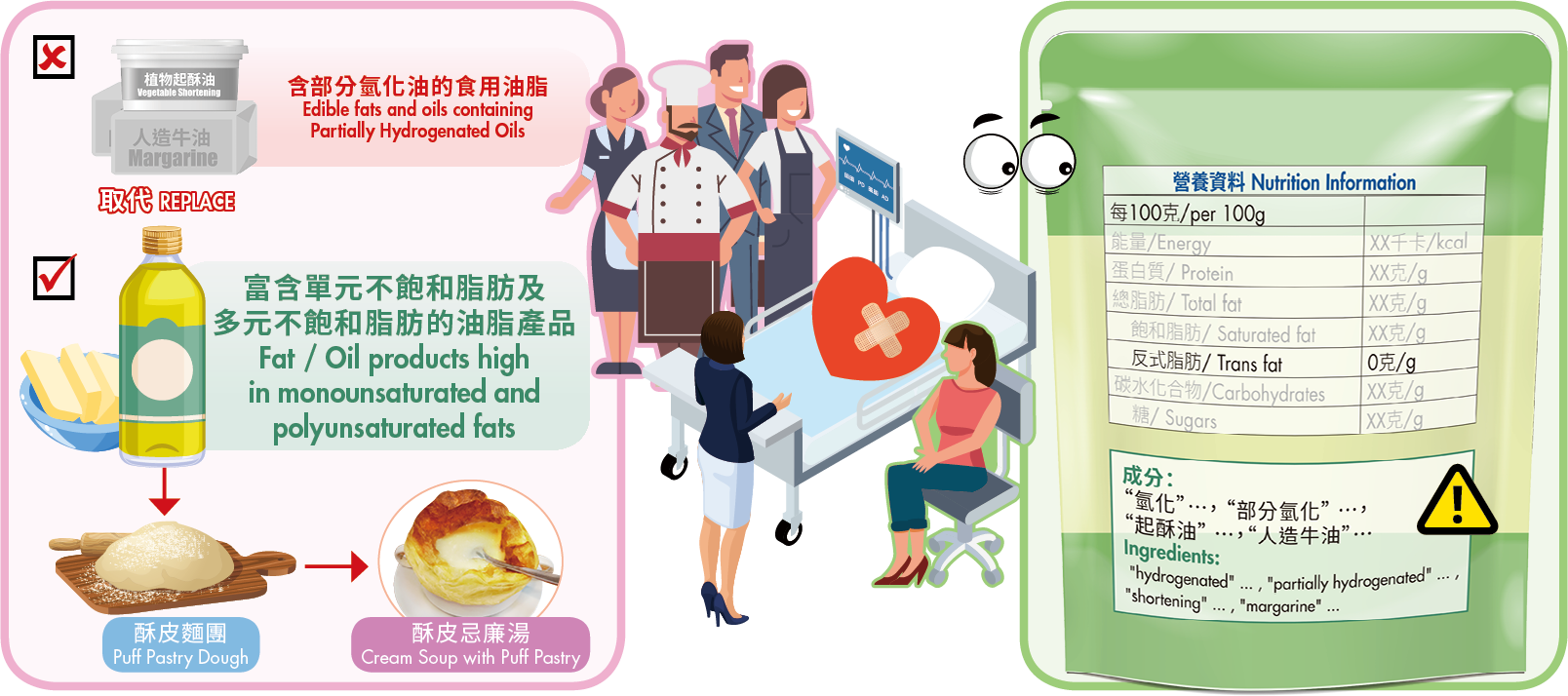
Food Safety Focus (149th Issue, December 2018) – Food Safety Platform
REPLACE Industrially-Produced Trans Fats to Protect Heart Health
Reported by Dr. Violette LIN, Scientific Officer,
Risk Assessment Section, Centre for Food Safety
In the last issue, we have illustrated how industrially-produced trans fats (IP-TFAs) could doubly jeopardise your heart health by lowering the “good” cholesterol and increasing the “bad” cholesterol. In this issue, we will explain how the trade could reduce the use of IP-TFAs from the food supply and how consumers could consume less foods with IP-TFAs to protect heart health.

Traders (by replacement) and consumers (by reading food label) both play a role in protecting heart health against industrially-produced trans fats.
How Can the Trade Reduce IP-TFAs in Foods?
Fats play important functional and sensory roles in food. For example, they are responsible for carrying, enhancing, and releasing the flavour of other ingredients, as well as for interacting with other ingredients to develop the texture and mouth feel characteristics of foods. Fats/oils also serve as a preservative to reduce the water activity of foods, prevent microbial growth and extend product shelf life. Furthermore, fats act as a heat transfer medium in frying. Using the cream soup with puff pastry quoted in the last issue as an example, let’s see what the trade could do to reduce the IP-TFAs in it.
The key to reduce IP-TFAs in foods is, first, realising the role and source of IP-TFAs in your products, then, replacing them with healthier alternatives. So, list out all the ingredients used in producing the food and spot those containing IP-TFAs. They are usually found in partially hydrogenated oil (PHO) products, such as margarine or vegetable shortening. In the cream soup with puff pastry example, it is possible that PHO-containing vegetable shortening was used in the dough for providing the crispy texture.
For replacing ingredients containing IP-TFAs, the World Health Organization’s REPLACE action package recommends the use of fats/oils high in polyunsaturated or monounsaturated fats. The “Trade Guidelines on Reducing Trans Fats in Food” issued by the Centre for Food Safety (CFS) lists out the fatty acid profiles of some oil/fat products (e.g. canola oil is high in monounsaturated fats). It also lists out various applications of oil/fat products containing reduced amount of TFAs (e.g. non-hydrogenated shortening blends of canola and safflower oils for baking pie crust). Consider using them when reformulating your food products. In addition, source for and purchase ingredients without IP-TFAs (ask the suppliers), which are now available in the market to cater for the increasing demand and address consumers’ interest.
How Can a Consumer Avoid Foods with IP-TFAs?
TFAs are usually presented in bakery products (e.g. bread, cakes, cookies), deep fried food (e.g. French fries, fried chicken, fried fritters) and margarine/margarine-like spreads. Maintain a balanced diet and reduce the intake of IP-TFAs by consuming these foods less often. The CFS has been assessing and monitoring TFAs content in the food supply through conducting risk assessment studies or joint studies with the Consumer Council since 2007. Use the TFAs content in foods available online in the designated reports and the Nutrient Information Inquiry System to avoid foods with TFAs.
Moreover, the Nutrition Labelling Scheme came into force since July 2010 mandates the labelling of TFAs content on prepackaged foods. Use the information on the food label (e.g. nutrition label, ingredient lists, and TFA-free claim) to choose foods without TFAs. Pay more attention to foods with words such as “hydrogenated”, “partially hydrogenated”, “shortening”, and “margarine”.
Protecting Your Heart Health from IP-TFAs Requires a Concerted Effort
On the one hand, the food Industry can change the manufacturing practices to produce foods without IP-TFAs, and consumers can be aware of food product choices. On the other hand, the CFS has been adopting a multi-prong approach to reduce the IP-TFAs intake in the population. Besides monitoring TFAs content in the food supply, the CFS has been communicating with the trade and educating consumers via different platforms (e.g. Trade Consultation Forum, trade guidelines, Facebook, seminars) on the ways and benefits of replacing IP-TFAs in foods.
Through promoting the replacement of IP-TFAs with healthier fats/oils, and together with creating awareness of the negative health impact of TFAs among various stakeholders, we could eliminate IP-TFAs from the food supply to protect your heart health.


